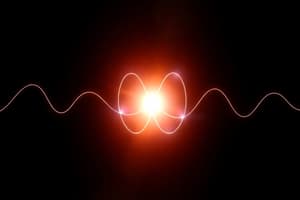Podcast
Questions and Answers
What concept did Neils Bohr introduce to address the limitations of Rutherford's atomic model?
What concept did Neils Bohr introduce to address the limitations of Rutherford's atomic model?
- Electrons have no mass and are distributed evenly around the nucleus.
- The nucleus contains only neutrons, influencing electron behavior.
- Electrons occupy discrete orbits with specific energies. (correct)
- Atoms are made up entirely of protons and neutrons.
What happens when an atom absorbs energy according to Bohr's model?
What happens when an atom absorbs energy according to Bohr's model?
- An electron jumps to a higher energy level. (correct)
- An electron is ejected from the atom.
- An electron moves to a lower energy level.
- The nucleus splits, releasing energy.
How is the stability of an atom primarily determined?
How is the stability of an atom primarily determined?
- By the number of neutrons in the nucleus.
- By the size of the nucleus compared to the electron cloud.
- By the total number of protons in the nucleus.
- By the number of electrons in the outermost energy level. (correct)
When an atom emits a photon, what does this signify?
When an atom emits a photon, what does this signify?
What is the relationship between photon frequency and energy levels?
What is the relationship between photon frequency and energy levels?
Flashcards are hidden until you start studying
Study Notes
Neils Bohr's Atomic Model Theory
- Building upon Rutherford’s atomic model, Bohr introduced the concept of electrons moving in specific and quantized orbits.
- Electrons can transition between these quantized orbits by absorbing or emitting energy in the form of electromagnetic radiation.
Electron Orbits and Energy Levels
- Electron orbits correspond to energy levels; the position of an electron in these orbits determines its energy.
- Electrons in lower energy levels possess greater stability compared to those situated in higher energy levels.
Energy Absorption and Emission in Atoms
- An atom can absorb energy, causing an electron to ascend to a higher energy level.
- Conversely, an atom can emit energy, which results in an electron transitioning to a lower energy level.
- The energy change during absorption or emission is equivalent to the energy difference between the involved energy levels.
Absorption and Emission of Photons
- Absorption of energy by an atom is associated with the intake of a photon when an electron jumps to a higher energy level.
- Emission of energy occurs when an atom releases a photon as an electron moves to a lower energy level.
- The frequency of the absorbed or emitted photon is directly proportional to the energy difference of the two energy levels.
Stability of the Atom Explained
- An atom's stability is largely dependent on the number of electrons in its outermost energy level.
- A stable atom is characterized by having a completely filled outermost energy level.
- Atoms can achieve stability through the loss, gain, or sharing of electrons.
Limitations of Rutherford's Atomic Model
- Rutherford's model fails to adequately describe the distribution of electrons within an atom.
- It does not account for the mechanisms by which atoms absorb and emit energy.
- Bohr's model addresses these gaps by introducing the idea of electron energy levels and the processes of photon absorption and emission.
Studying That Suits You
Use AI to generate personalized quizzes and flashcards to suit your learning preferences.




